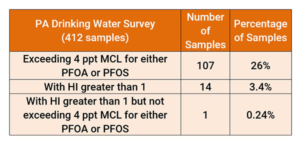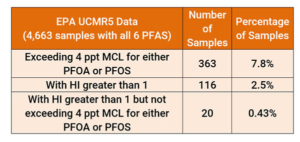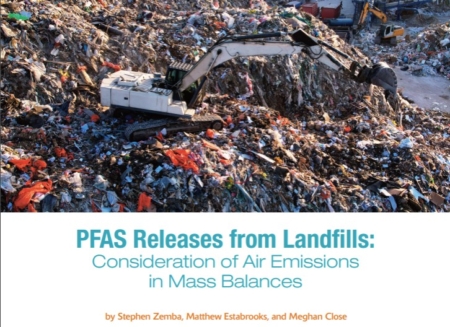The U.S. Environmental Protection Agency (EPA) is in the midst of considering public comments on its proposed Maximum Contaminant Levels (MCLs) for per- and polyfluoroalkyl substances (PFAS), and the degree to which it adopts or modifies the proposed standards could serve as an indicator for the direction of future PFAS regulations. EPA has set ambitious targets to establish regulations within essentially all of its legislated programs. Although not every goal set forth in the PFAS Strategic Roadmap has been met, the pace and scope of progress has been impressive. The regulatory approach in the past few years has been conservative with respect to resolving uncertainties, which has translated to protective decisions and stringent criteria.
EPA’s actions have focused in large part on drinking water regulations, which makes sense given it is typically the dominant exposure pathway to PFAS. In December 2022, EPA not only established Lifetime Health Advisories (HAs) for two new PFAS (PFBS and GenX), but expanded its Roadmap promise to also revise its 70 parts per trillion (ppt) HA for PFOA and PFOS downward to undetectable levels (implying health concerns at levels much lower than the proposed 4 ppt MCLs, which are based on reliably achievable detection limits). In a similar vein of extending regulations, EPA’s proposed MCLs include provision to establish a Hazard Index (HI) approach to regulate four PFAS – PFBS, PFHxS, PFNA, and GenX – in addition to PFOA and PFOS. This will be the first time that EPA has needed to consider public comments on the toxicity evidence underlying its proposed regulations, as HAs are issued without public input. Given the notions that (1) most knowledge of PFAS toxicity stems from studies on PFOA and PFOS, (2) there are considerable uncertainties with regard to PFAS toxicity in general, and (3) there has been limited study of compounds such as PFBS, PFHxS, PFNA, and GenX, it will be interesting to see how the EPA responds to comments on PFAS toxicity.
Although EPA’s proposal to expand standards beyond PFOA and PFOS is a first step to address the host of PFAS that have been introduced to the environment, it does not follow the historical process for establishing MCLs for unregulated contaminants, which first requires a determination of need through the Unregulated Contaminant Monitoring Rule (UCMR). Since UCMR5 includes PFBS, PFHxS, PFNA, and GenX among its target compounds, the proposed HI approach seems to be a new and expedited approach to developing MCLs. In the past, the need to establish new MCLs has relied on an evaluation of occurrence of contaminant concentrations above risk-exposure thresholds at sufficient frequency to warrant regulation. Recent occurrence data from state drinking water surveys indicate low frequencies of exceedance of the HI target criterion, and very few instances of it triggering additional need for mitigation. For example, Pennsylvania’s drinking water survey found 26% of samples contained either PFOA or PFOS (or both) at levels exceeding the EPA’s proposed 4 ppt MCLs. However, only 3.4% of the samples had HIs greater than 1 based on EPA’s proposed toxicity reference values for PFBS, PFHxS, PFNA, and GenX, and of these samples, in only one case (of the 412 samples) did the HI exceed 1 but have PFOA and PFOS concentrations less than 4 ppt.

A similarly small incremental impact of the HI criterion is indicated by the first installment of the EPA’s UCMR5 data. The percentage of samples exceeding both the 4 ppt PFOA/PFOS MCLs is smaller in the national data, as is the percentage of samples with HIs greater than 1, but only a small additional percentage of samples exceed the HI target criterion alone. Since the first UCMR5 data installment reflects only 7% of the anticipated data, these preliminary percentages should be viewed with caution.

Another key aspect of MCL development is evaluating economic benefit. In the case of the proposed HI approach, EPA’s economic analysis indicates minimal net benefits. Examining the differences in the incremental benefits and costs for EPA proposed option (with the HI) and the proposed 4 ppt MCLs for PFOA and PFOS alone, the net benefits of the HI approach are negative for four of the six scenarios considered by EPA as indicated in the following table.
Annualized Net Benefits of the HI Approach (in millions of $2021, as calculated from EPA estimates between benefits/costs between the proposed option with the HI and Option 1a with only PFOA and PFOS MCLs)

Thus, notwithstanding the novelty of the proposed HI approach and its inconsistency with precedent MCL regulations, EPA’s presented benefit analysis appears to provide limited support benefit to the additional HI-based MCL for PFBS, PFHxS, PFNA, and GenX. EPA has in other programs proposed regulations to gather comments and perspectives. We expect that the HI approach will generate interesting and perhaps plentiful public comments, and hence may inform EPA on the merits of future regulatory proposals for PFAS.
Posted In: Articles
Tagged In: EPA, PFAS, Regulations, Research




